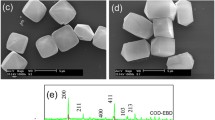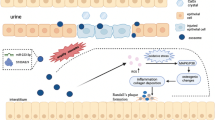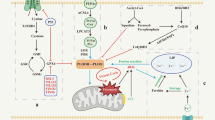Abstract
Calcifying nanoparticles (CNPs) play an important role in kidney stone formation, but the mechanism(s) are unclear. CNPs were isolated and cultured from midstream urine of patients with kidney stones. CNP morphology and characteristics were examined by electron microscopy and electrophoresis analysis. Chemical composition was analyzed using energy-dispersive X-ray microanalysis and Western blotting. Human renal proximal convoluted tubule cell (HK-2) cultures were exposed to CNPs for 0, 12 and 72 h, and production of reactive oxygen species (ROS), mitochondrial membrane potential and apoptosis levels were evaluated. CNPs isolated from patients showed classical morphology, the size range of CNPs were 15–500 nm and negative charge; they were found to contain fetuin-A. Exposure of HK-2 cells to CNPs induced ROS production, decreased mitochondrial membrane potential and decreased cell viability. Transmission electron microscopy showed that CNPs can enter the cell by phagocytosis, and micrographs revealed signs of apoptosis and autophagy. CNPs increased the proportion of apoptotic cells, down-regulated Bcl-2 expression and up-regulated Bax expression. CNPs also up-regulated expression of LC3-B, Beclin-1and p-JNK.CNPs are phagocytosed by HK-2 cells, leading to autophagy, apoptosis and ROS production, in part through activation of JNK signaling pathways. ROS and JNK pathways may contribute to CNP-induced cell injury and kidney stone formation.









Similar content being viewed by others
References
Wang WJ, Fan JY, Huang GF, Li J, Zhu X, Tian Y, Su L(2017) Prevalence of kidney stones in mainland China: a systematic review. Sci Rep 7:41630
Romero V, Akpinar H, Assimos DG (2010) Kidney stones: a global picture of prevalence, incidence, and associated risk factors. Rev Urol 12:e86–e96
Sutherland JW, Parks JH, Coe FL (1985) Recurrence after a single renal stone in a community practice. Miner Electrolyte Metab 11(4):267–269
Randall A (1937) The origin and growth of renal calculi. Ann Surg 105(6):1009–1027
Çiftçioglu N, Kajander EO (1998) Interaction of nanobacteria with cultured mammalian cells. Pathophysiology 4:259–270
Cisar JO, Xu DQ, Thompson J, Swaim W, Hu L, Dennis J (2000) An alternative interpretation of nanobacteria-induced biomineralization. PNAS 97(21):11511–11515
Miller VM, Rodgers G, Charlesworth JA, Kirkland B, Severson SR, Rasmussen TE, Yagubyan M, Rodgers JC, Cockerill FR 3rd, Folk RL, Rzewuska-Lech E, Kumar V, Farell-Baril G, Lieske JC (2004) Evidence of nanobacterial-like structures in calcified human arteries and cardiac valves. Am J Physiol Heart Circ Physiol 287(3):H1115–24. https://doi.org/10.1152/ajpheart.00075.2004
Martel J, Peng HH, Young D, Wu CY, Young JD (2014) Of nanobacteria, nanoparticles, biofilms and their role in health and disease: facts, fancy and future. Nanomedicine 9(4):483–499
Ciftcioglu N, Vejdani K, Lee O, Mathew G, Aho KM, Kajander EO, McKay DS, Jones JA, Stoller ML (2008) Association between Randall’s plaque and calcifying nanoparticles. Int J Nanomed 3(1):105–115
Zhang MJ, Liu SN, Xu G, Guo YN, Fu JN, Zhang DC (2014) Cytotoxicity and apoptosis induced by nanobacteria in human breast cancer cells. Int J Nanomed 9:265–271. https://doi.org/10.2147/IJN.S54906
Zhang M, Yang J, Shu J, Fu C, Liu S, Xu G, Zhang D (2014) Cytotoxicity induced by nanobacteria and nanohydroxyapatites in human choriocarcinoma cells. Nanoscale Res Lett 9(1):616. https://doi.org/10.1186/1556-276X-9-616
Wong T-Y, Wu C-Y, Martel J (2015) Detection and characterization of mineralo-organic nanoparticles in human kidneys. Sci Rep 5:15272
Miller C, Kennington L, Cooney R, Kohjimoto Y, Cao LC, Honeyman T, Pullman J, Jonassen J, Scheid C (2000) Oxalate toxicity in renal epithelial cells: characteristics of apoptosis and necrosis. Toxicol Appl Pharmacol 162(2):132–141. https://doi.org/10.1006/taap.1999.8835
Kajander EO, Kuronen I, Akerman KK (1997) Nanobacteria from blood: the smallest culturable autonomously replicating agent on earth. SPIE Proc 3111:420–428
Trinchieri A (1996) Epidemiology of urolithiasis. Arch Ital Urol Androl 68(4):203–249
Evan AP, Lingeman JE, Coe FL, Parks JH, Bledsoe SB (2003) Randall’s plaque of patients with nephrolithiasis begins in basement membranes of thin loops of Henle. J Clin Investig 111(5):607–616. https://doi.org/10.1172/JCI200317038
Evan AP (2010) Physiopathology and etiology of stone formation in the kidney and the urinary tract. Pediatr Nephrol 25(5):831–841
Smirnov GV, Smirnov DG (2008) Nannobacteria: a new ecological threat. Contemp Probl Ecol 1:111–114
Kajander EO, Ciftcioglu N (1998) Nanobacteria: an alternative mechanism for pathogenic intra- and extracellular calcification and stone formation. Proc Natl Acad Sci USA 95(14):8274–8279
Kajander EO, Ciftcioglu N, Aho K, Garcia-Cuerpo E (2003) Characteristics of nanobacteria and their possible role in stone formation. Urol Res 31(2):47–54. https://doi.org/10.1007/s00240-003-0304-7
Akerman KK, Kuikka JT, Cificioglu N (1997) Radio labeling and in vivo distribution of nanobacteria in rabbit. Proc SPIE 13:436–442
Coe FL, Evan A, Worcester E (2005) Kidney stone disease. J Clin Invest 115(10):2598–2608. https://doi.org/10.1172/JCI26662
Grases F, March JG, Conte A, Costa-Bauza A (1993) New aspects on the composition, structure and origin of calcium oxalate monohydrate calculi. Eur Urol 24(3):381–386
Abraham PA, Smith CL (1987) Evaluation of factors involved in calcium stone formation. Miner Electrolyte Metab 13(3):201–208
Ciftcioglu N, Haddad RS, Golden DC, Morrison DR, McKay DS (2005) A potential cause for kidney stone formation during space flights: enhanced growth of nanobacteria in microgravity. Kidney Int 67(2):483–491. https://doi.org/10.1111/j.1523-1755.2005.67105.x
Raoult D, Drancourt M, Azza S, Nappez C, Guieu R, Rolain JM, Fourquet P, Campagna B, La Scola B, Mege JL, Mansuelle P, Lechevalier E, Berland Y, Gorvel JP, Renesto P (2008) Nanobacteria are mineralo fetuin complexes. PLoS Pathog 4(2):e41. https://doi.org/10.1371/journal.ppat.0040041
Chabriere E, Gonzalez D, Azza S, Durand P, Shiekh FA, Moal V, Baudoin JP, Pagnier I, Raoult D (2014) Fetuin is the key for nanon self-propagation. Microb Pathog 73:25–30. https://doi.org/10.1016/j.micpath.2014.05.003
Verkoelen CF, van der Boom BG, Houtsmuller AB, Schroder FH, Romijn JC (1998) Increased calcium oxalate monohydrate crystal binding to injured renal tubular epithelial cells in culture. Am J Physiol 274(5 Pt 2):F958–965
Choi AM, Ryter SW, Levine B (2013) Autophagy in human health and disease. N Engl J Med 368(7):651–662. https://doi.org/10.1056/NEJMra1205406
Scherz-Shouval R, Elazar Z (2011) Regulation of autophagy by ROS: physiology and pathology. Trends Biochem Sci 36(1):30–38. https://doi.org/10.1016/j.tibs.2010.07.007
Ki YW, Park JH, Lee JE, Shin IC, Koh HC (2013) JNK and p38 MAPK regulate oxidative stress and the inflammatory response in chlorpyrifos-induced apoptosis. Toxicol Lett 218(3):235–245. https://doi.org/10.1016/j.toxlet.2013.02.003
Salazar M, Carracedo A, Salanueva IJ, Hernandez-Tiedra S, Lorente M, Egia A, Vazquez P, Blazquez C, Torres S, Garcia S, Nowak J, Fimia GM, Piacentini M, Cecconi F, Pandolfi PP, Gonzalez-Feria L, Iovanna JL, Guzman M, Boya P, Velasco G (2009) Cannabinoid action induces autophagy-mediated cell death through stimulation of ER stress in human glioma cells. J Clin Invest 119(5):1359–1372
Pan X, Zhang X, Sun H, Zhang J, Yan M, Zhang H (2013) Autophagy inhibition promotes 5-fluorouraci-induced apoptosis by stimulating ROS formation in human non-small cell lung cancer A549 cells. PLoS One 8(2):e56679. https://doi.org/10.1371/journal.pone.0056679
Eisenberg-Lerner A, Bialik S, Simon HU, Kimchi A (2009) Life and death partners: apoptosis, autophagy and the cross-talk between them. Cell Death Differ 16(7):966–975. https://doi.org/10.1038/cdd.2009.33
Nikoletopoulou V, Markaki M, Palikaras K, Tavernarakis N (2013) Crosstalk between apoptosis, necrosis and autophagy. Biochim Biophys Acta 1833(12):3448–3459. https://doi.org/10.1016/j.bbamcr.2013.06.001
Moretti L, Cha YI, Niermann KJ, Lu B (2007) Switch between apoptosis and autophagy: radiation-induced endoplasmic reticulum stress? Cell Cycle 6(7):793–798. https://doi.org/10.4161/cc.6.7.4036
Wong CH, Iskandar KB, Yadav SK, Hirpara JL, Loh T, Pervaiz S (2010) Simultaneous induction of non-canonical autophagy and apoptosis in cancer cells by ROS-dependent ERK and JNK activation. PLoS One 5(4):e9996. https://doi.org/10.1371/journal.pone.0009996
Wei Y, Pattingre S, Sinha S, Bassik M, Levine B (2008) JNK1-mediated phosphorylation of Bcl-2 regulates starvation-induced autophagy. Mol Cell 30(6):678–688. https://doi.org/10.1016/j.molcel.2008.06.001
Kim EM, Yang HS, Kang SW, Ho JN, Lee SB, Um HD (2008) Amplification of the gamma-irradiation-induced cell death pathway by reactive oxygen species in human U937 cells. Cell Signal 20(5):916–924. https://doi.org/10.1016/j.cellsig.2008.01.002
Funding
This work was supported by grants from the National Natural Science Foundation of China (No. 81760127, 81360113, 30860280 and 30960455), the Guangxi Natural Science Foundation (No. 2017GXNSFAA198070). We are grateful to the members of the Electron Microscopy Group in the Department of Life Science at Guangxi Medical University, Guangxi, and People’s Republic of China.
Author information
Authors and Affiliations
Corresponding authors
Ethics declarations
Conflict of interest
All authors declare that they have no any conflict of interests.
Ethical approval
The study protocol was approved by the Ethics Committee of Guangxi Medical University (Guangxi, China).
Informed consent
Informed consent was obtained from all individual participants included in the study.
Rights and permissions
About this article
Cite this article
Wu, J., Tao, Z., Deng, Y. et al. Calcifying nanoparticles induce cytotoxicity mediated by ROS-JNK signaling pathways. Urolithiasis 47, 125–135 (2019). https://doi.org/10.1007/s00240-018-1048-8
Received:
Accepted:
Published:
Issue Date:
DOI: https://doi.org/10.1007/s00240-018-1048-8




